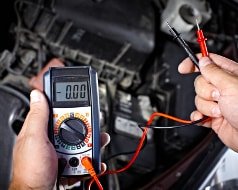Testing the function of the alternator: This is how professionals test and measure
When operating properly, the alternator (LiMa) provides the required direct current in the vehicle and simultaneously charges the car battery. If the LiMa does not fulfill this task, the car's power supply will break down sooner or later. That is why the functionality of the LiMa is displayed from the cockpit via the charge control light (LKL). If the ignition is switched on before the engine starts, the display lights up because all consumers are only supplied with energy via the battery. If the engine is started, the LKL goes out again because the supply and charging current is now provided directly by the alternator.
If the LKL continues to glow, glow or flicker while driving, you should immediately schedule an appointment in the workshop to have the alternator tested. Find out here how workshops check the alternator's direct current and how the alternator's charge regulator is checked. Find reliable specialist workshops in your area that check and repair the regulator of the alternator. At the same time, you can compare the costs of repairing the defective alternator and make an appointment online with the workshop of your choice.
Read more: How to test your alternator: TROUBLESHOOTING
Checking the alternator - a job for professionals
Various defects can be considered as the cause of a defective alternator. Only by carefully and systematically testing and measuring the alternator can you find out exactly where the fault is to be found. These systematic work steps, the necessary specialist knowledge and the measuring devices are convincing reasons to have the alternator checked quickly and safely in the workshop. The workshop can find out relatively quickly whether the alternator or regulator is defective and where the cause of the error is by taking the following steps:
- visual inspection of the alternator (visual inspection)
- Check the alternator's direct current
- Check the alternator regulator
- Test the function of the alternator
In addition, the workshop offers the best conditions in the event that the alternator has to be removed or replaced. But before the alternator is really replaced, the fault must first be found. It may not be necessary to change, but the damage can also be repaired this way.
Read more: 7 reasons why the battery light is on
Visually check the alternator
Testing the function of the alternator - the expert begins with a comprehensive visual inspection of the alternator and all peripheral components such as the belt drive, the alternator regulator and the cabling. The specialist examines all cables, ground straps and connections on the alternator as well as on the car's battery. The tension of the V-belt is also checked; the play should not be more than two centimeters at the longest free point. Testing the battery is also part of a professional diagnostic process, since the alternator and car battery must always be viewed as one system. The expert also pays attention to unusual noises from the alternator during troubleshooting. A whistling or regular clacking indicates, for example, defective bearings or a defective freewheel. In this case, the expert can check the freewheeling of the alternator.
Checking the alternator without a measuring device
If troubleshooting during the visual inspection of the alternator is unsuccessful, the experts test the DC alternator for common defects. Here, the damage profile gives the specialist important clues. The testing includes, for example, the function of the charge control lamp itself, the examination of any interrupted cables or corroded connections or the identification of defects in the generator's regulator. If the charge indicator lamp lights up or glows continuously while driving, a short circuit to ground could also be the problem for the defect.
Check the alternator with a measuring device
If the problem is not found during the optical and mechanical test, the expert will pick up his measuring device. This will measure all components of the alternator.
Check the alternator's direct current
The use of the multimeter begins with measuring the charging voltage that is emitted by the alternator. To measure the charging current of the alternator, a test run is carried out at idle and once at a speed of 4,000 revolutions per minute. If no DC voltage is measured in one of the two test measurements, the alternator is defective.
Is the alternator or regulator defective? Testing the voltage difference
If everything is OK at this point, the specialist measures the voltage difference between the alternator and the battery. Conclusions about the cause of the error can also be drawn from these values. A working alternator has a voltage between 13.8 and 14.4 volts. If the voltage arriving at the battery is more than one volt lower when the loads are switched on, the fault is most likely to be found in the cabling. If, on the other hand, the voltage on the alternator is significantly higher, the cause of the defect is more likely to be found in the alternator regulator. The alternator regulator - regulator for short - is responsible for regulating the charging current and protecting the on-board network from excessively high voltages.
Measuring the alternator with special equipment
If the defect in the alternator has still not been identified after these tests and efforts, the expert in the workshop will use an oscilloscope and clamp meter. With this equipment, he is able to measure individual currents in the vehicle. An oscilloscope visualizes the course of the measured values. The charging current of the alternator is measured, and the so-called quiescent current and the excitation current are also subjected to a test. The expert can also use the oscilloscope to analyze whether the so-called harmonic ripple is within the ideal range. This tells you whether the vehicle's voltage regulator is working properly. Any fault on the alternator should be discovered at the latest during these special tests.



0 Response to "Testing the function of the alternator: This is how professionals test and measure"
Post a Comment